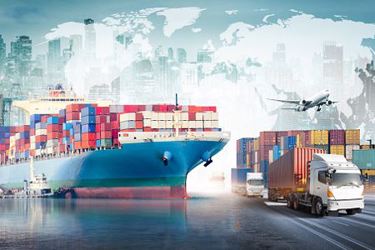Supply Chain Disruptions Don't Have To Cause Headaches For Water Systems
By John DeLuca

Supply chain disruptions and subsequent delays aren’t only affecting retailers and electronics manufacturers these days. In fact, they’re also making life difficult for water systems and the people and communities they serve.
Case in point: The cost of some of the products needed to run water systems has skyrocketed. MCP Group’s latest report on construction material outlook outlines just how significantly material prices have risen — PVC’s price tag has jumped 165 percent from 2020, steel pipe’s by 145 percent, and copper’s by 75 percent.1 As the report also notes, the COVID-19 pandemic hasn’t been the only culprit tinkering with cost fluctuations, either. Damage to manufacturing facilities during Texas’ early 2021 ice storms had an impact, too.1
The price of items isn’t the only supply chain worry, however. There’s a huge backlog of orders of all sorts of materials and equipment needed by water systems. And in some cases, critical items simply aren’t available at all, even when water systems have the necessary funds for them. This can cause serious repair delays, ultimately impacting water quality.
The U.S. Environmental Protection Agency addressed this problem in a June 2021 letter to its chemical sector providers.2 The letter affirmed the agency’s desire to help avoid a crisis caused by a lack of water treatment chemicals. Yet the document also warned of potential issues despite its commitment to finding solutions.
Of course, these supply chain challenges aren’t happening in a vacuum. Yes, they’re affecting water systems and their personnel. But they’re just as clearly influencing consumers from both a health and pocketbook perspective.
How Supply Chain Issues Impact Customers
Consumers might not have felt supply chain hiccups as early as water systems did. Regardless, they’re beginning to experience them financially at this point.
Water systems are now facing increased overall project, labor, and maintenance costs. Accordingly, many are passing those costs along to customers in the form of higher rates. All this is happening, however, at a time when the price of other basic needs is rising significantly.3 Not surprisingly, plenty of customers are growing frustrated as their budgets are stretched thin.
To be sure, consumers have been feeling water bill-related financial strains for longer than the pandemic. A research study released by The Guardian in June 2020 highlighted a 27 percent rise (at the very least) in consumer water costs between 2010 and 2018.4 Concurrent with the rise was a dip in federal aid to public water systems, which happen to serve the majority of the U.S. population. The report highlights that these water rate hikes aren’t sustainable — especially for lower-income households.
Here’s the Catch-22, though: Water systems can’t just kick repairs and replacements down the road to avoid raising prices. Waiting too long to address critical breakdowns and aging systems will inevitably lead to even higher costs due to the expansion of scopes of work, not to mention rising material rates. Plus, attempting to get by with antiquated or failing water and wastewater systems could hurt them from quality and regulatory standpoints. One compliance misstep or fine could make matters much worse.
So what’s the answer for water systems eager to respond to supply chain disruptions in pragmatic, practical ways? Below are a few options that can help mitigate this situation:
1. Aim for creative collaboration among water supply system providers.
Now could be the perfect time for neighboring water supply systems to combine orders or share vendor data. After all, these types of informal partnerships might prove beneficial in the hunt for available materials. They could also spur creative supply chain solutions, such as bumping up shared stock.
For example, most water supply systems can predict the items they’ll need in the coming quarters or years for materials, replacements, and repairs. Buying items when they’re available avoids systems finding that they’re out of stock again when an emergency arises. Certainly, this type of upfront purchasing arrangement might change the water system’s typical budget flow and require approval. At the same time, it can avoid interruptions and might even cost less in the long run.
Remember: Many products are expected to grow more expensive into 2022 and perhaps beyond. Paying for them now can be frugal. And if water systems make large purchases together, they might be eligible for better discounts from suppliers.
2. Source alternatives if primary items aren’t available.
Finding alternatives to commonly used products can be another way to sidestep the supply chain crisis overtaking utility systems across the country. Consider chemical treatments, for instance; water systems might be able to use different types of chemicals to achieve the same objectives.
In fact, the Washington State Department of Health has earmarked chloramines, chlorine dioxide, ozone, and ultraviolet radiation as acceptable alternative disinfectants during water treatment processes.5 Consequently, water systems might want to experiment with such alternatives if they’re having trouble sourcing the chemicals they currently use.
Another example of finding alternatives could be extending the vendor list systems use. Currently, many vendors are undergoing not only supply chain woes, but also widespread labor shortages and even trade concerns. Identifying, interviewing, and approving different vendors could be a way to keep drinking water safe and usable and ensure wastewater is properly treated.
3. Generate plans to address future disruptions.
The pandemic demonstrated just how important it is for all organizations to have emergency plans in place. Water systems should use what they’ve learned recently to construct plans to handle supply chain issues and other types of disruptions down the road.
It’s admittedly difficult to predict when disruptions will occur again or how they might impact supplies, labor, and materials. Nevertheless, having a long-range capital expenditure plan in place can help alleviate these types of problems. Systems can refer to their plans as needed, leveraging them at the start of problems to skirt long-term obstacles and ensure smooth, efficient operations.
What should this type of emergency planning document include? It might be reasonable to address everything from natural disasters (like extreme weather shifts and drought) to healthcare emergencies (like the rise of another pandemic). Ultimately, being prepared and proactive will help water systems navigate turbulent times and rebound appropriately.
Like all public utilities, water systems are in a unique situation when it comes to facing supply chain disruptions and other concerns. Unlike plenty of other companies, however, they can’t stop or temporarily suspend operations — the country is far too dependent on their services. This forces them to come up with innovative ways to keep serving the people who need what they produce. Fortunately, many experts predict that most hard-to-find materials will come on the market again by the end of 2022. In the meantime, water systems just need to find ways to plug the gaps without losing momentum.
 John DeLuca is the vice president and senior relationship manager of the Water and Community Facilities division at CoBank, a national cooperative bank serving vital industries across rural America by providing loans, leases, export financing, and other financial services in all 50 states. In his current role at CoBank, John works to provide credit and financial opportunities to nonprofit and municipal water and wastewater facilities across 10 states and manages a portfolio of around 80 customers. Previously, John served as senior director at Fitch Ratings and was a senior VP and consultant at Radian Asset Assurance. He holds a bachelor’s in marketing from Hofstra University.
John DeLuca is the vice president and senior relationship manager of the Water and Community Facilities division at CoBank, a national cooperative bank serving vital industries across rural America by providing loans, leases, export financing, and other financial services in all 50 states. In his current role at CoBank, John works to provide credit and financial opportunities to nonprofit and municipal water and wastewater facilities across 10 states and manages a portfolio of around 80 customers. Previously, John served as senior director at Fitch Ratings and was a senior VP and consultant at Radian Asset Assurance. He holds a bachelor’s in marketing from Hofstra University.
References
- https://themcpgroup.com/construction-material-outlook-q4-2021/
- https://www.waterisac.org/system/files/articles/Letter%20to%20Chemical%20Sector%20from%20
EPA%20Administrator.pdf - https://www.wsj.com/articles/us-inflation-consumer-price-index-october-2021-11636491959
- https://www.theguardian.com/us-news/2020/jun/23/millions-of-americans-cant-afford-water-bills-rise
- https://www.doh.wa.gov/portals/1/Documents/pubs/331-252.pdf
